Standard [CURRENT]
ASTM E 468/E 468Ma:2023
Standard Practice for Presentation of Constant Amplitude Fatigue Test Results for Metallic Materials
- German title
- Richtlinien für die Darstellung der Ergebnisse von Dauerversuchen an metallischen Werkstoffen mit amplituden-konstanter Schubbelastung
- Publication date
- 2023
- Original language
- English
- Pages
- 7
- Publication date
- 2023
- Original language
- English
- Pages
- 7
- DOI
- https://dx.doi.org/10.1520/E0468_E0468M-23A
Product information on this site:
Quick delivery via download or delivery service
Buy securely with a credit card or pay upon receipt of invoice
All transactions are encrypted
Short description
1.1 This practice covers the desirable and minimum information to be communicated between the originator and the user of data derived from constant-force amplitude axial, bending, or torsion fatigue tests of metallic materials tested in air and at room temperature. Note 1: Practice E466 , although not directly referenced in the text, is considered important enough to be listed in this standard. 1.2 The values stated in either SI units or inch-pound units are to be regarded separately as standard. The values stated in each system are not necessarily exact equivalents; therefore, to ensure conformance with the standard, each system shall be used independently of the other, and values from the two systems shall not be combined. 1.3 This standard does not purport to address all of the safety concerns, if any, associated with its use. It is the responsibility of the user of this standard to establish appropriate safety, health, and environmental practices and determine the applicability of regulatory limitations prior to use. 1.4 This international standard was developed in accordance with internationally recognized principles on standardization established in the Decision on Principles for the Development of International Standards, Guides and Recommendations issued by the World Trade Organization Technical Barriers to Trade (TBT) Committee.
ICS
77.040.10
DOI
https://dx.doi.org/10.1520/E0468_E0468M-23A
Also available in
Loading recommended items...
Loading recommended items...
Loading recommended items...
Loading recommended items...

